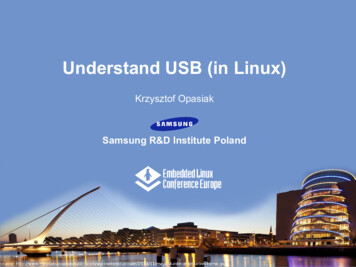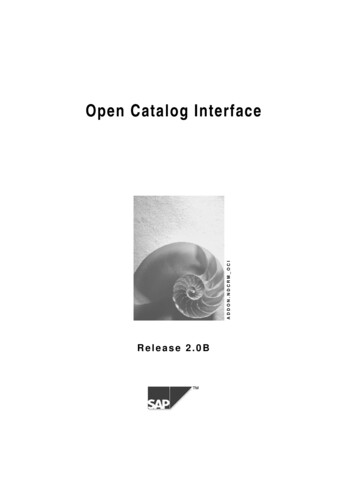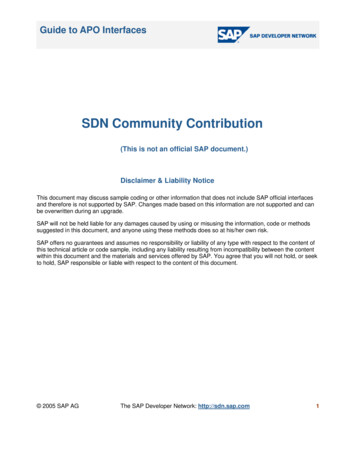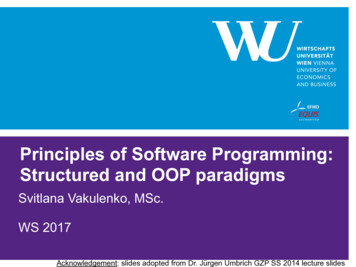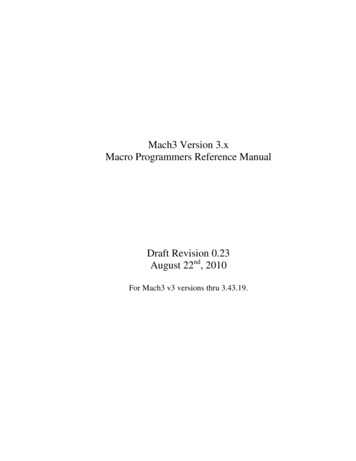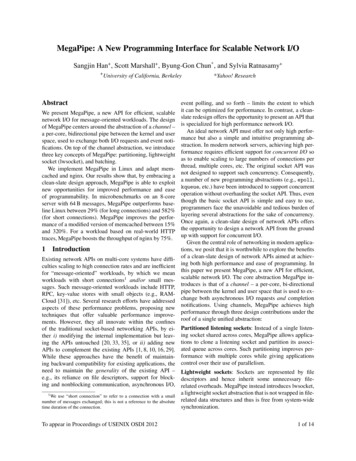
Transcription
MegaPipe: A New Programming Interface for Scalable Network I/OSangjin Han , Scott Marshall , Byung-Gon Chun* , and Sylvia Ratnasamy University of California, BerkeleyAbstractWe present MegaPipe, a new API for efficient, scalablenetwork I/O for message-oriented workloads. The designof MegaPipe centers around the abstraction of a channel –a per-core, bidirectional pipe between the kernel and userspace, used to exchange both I/O requests and event notifications. On top of the channel abstraction, we introducethree key concepts of MegaPipe: partitioning, lightweightsocket (lwsocket), and batching.We implement MegaPipe in Linux and adapt memcached and nginx. Our results show that, by embracing aclean-slate design approach, MegaPipe is able to exploitnew opportunities for improved performance and easeof programmability. In microbenchmarks on an 8-coreserver with 64 B messages, MegaPipe outperforms baseline Linux between 29% (for long connections) and 582%(for short connections). MegaPipe improves the performance of a modified version of memcached between 15%and 320%. For a workload based on real-world HTTPtraces, MegaPipe boosts the throughput of nginx by 75%.1IntroductionExisting network APIs on multi-core systems have difficulties scaling to high connection rates and are inefficientfor “message-oriented” workloads, by which we meanworkloads with short connections1 and/or small messages. Such message-oriented workloads include HTTP,RPC, key-value stores with small objects (e.g., RAMCloud [31]), etc. Several research efforts have addressedaspects of these performance problems, proposing newtechniques that offer valuable performance improvements. However, they all innovate within the confinesof the traditional socket-based networking APIs, by either i) modifying the internal implementation but leaving the APIs untouched [20, 33, 35], or ii) adding newAPIs to complement the existing APIs [1, 8, 10, 16, 29].While these approaches have the benefit of maintaining backward compatibility for existing applications, theneed to maintain the generality of the existing API –e.g., its reliance on file descriptors, support for blocking and nonblocking communication, asynchronous I/O,*Yahoo! Researchevent polling, and so forth – limits the extent to whichit can be optimized for performance. In contrast, a cleanslate redesign offers the opportunity to present an API thatis specialized for high performance network I/O.An ideal network API must offer not only high performance but also a simple and intuitive programming abstraction. In modern network servers, achieving high performance requires efficient support for concurrent I/O soas to enable scaling to large numbers of connections perthread, multiple cores, etc. The original socket API wasnot designed to support such concurrency. Consequently,a number of new programming abstractions (e.g., epoll,kqueue, etc.) have been introduced to support concurrentoperation without overhauling the socket API. Thus, eventhough the basic socket API is simple and easy to use,programmers face the unavoidable and tedious burden oflayering several abstractions for the sake of concurrency.Once again, a clean-slate design of network APIs offersthe opportunity to design a network API from the groundup with support for concurrent I/O.Given the central role of networking in modern applications, we posit that it is worthwhile to explore the benefitsof a clean-slate design of network APIs aimed at achieving both high performance and ease of programming. Inthis paper we present MegaPipe, a new API for efficient,scalable network I/O. The core abstraction MegaPipe introduces is that of a channel – a per-core, bi-directionalpipe between the kernel and user space that is used to exchange both asynchronous I/O requests and completionnotifications. Using channels, MegaPipe achieves highperformance through three design contributions under theroof of a single unified abstraction:Partitioned listening sockets: Instead of a single listening socket shared across cores, MegaPipe allows applications to clone a listening socket and partition its associated queue across cores. Such partitioning improves performance with multiple cores while giving applicationscontrol over their use of parallelism.Lightweight sockets: Sockets are represented by filedescriptors and hence inherit some unnecessary filerelated overheads. MegaPipe instead introduces lwsocket,a lightweight socket abstraction that is not wrapped in file1 We use “short connection” to refer to a connection with a smallnumber of messages exchanged; this is not a reference to the absolute related data structures and thus is free from system-widetime duration of the connection.synchronization.To appear in Proceedings of USENIX OSDI 20121 of 14
System Call Batching: MegaPipe amortizes system call side processing happens on the core at which the applioverheads by batching asynchronous I/O requests and cation thread for the flow resides. Because of the serialcompletion notifications within a channel.ization in the listening socket, an application thread callWe implemented MegaPipe in Linux and adapted two ing accept() may accept a new connection that camepopular applications – memcached [3] and the nginx [37] through a remote core; RX/TX processing for the flow– to use MegaPipe. In our microbenchmark tests on an 8- occurs on two different cores, causing expensive cachecore server with 64 B messages, we show that MegaPipe bouncing on the TCP control block (TCB) between thoseoutperforms the baseline Linux networking stack between cores [33]. While the per-flow redirection mechanism [7]29% (for long connections) and 582% (for short connec- in NICs eventually resolves this core disparity, short contions). MegaPipe improves the performance of a mod- nections cannot benefit since the mechanism is based onified version of memcached between 15% and 320%. packet sampling.For a workload based on real-world HTTP traffic traces,MegaPipe improves the performance of nginx by 75%.The rest of the paper is organized as follows. We expand on the limitations of existing network stacks in §2,then present the design and implementation of MegaPipein §3 and §4, respectively. We evaluate MegaPipe with microbenchmarks and macrobenchmarks in §5, and reviewrelated work in §6.File Descriptors (single/multi-core): The POSIX standard requires that a newly allocated file descriptor be thelowest integer not currently used by the process [6]. Finding ‘the first hole’ in a file table is an expensive operation,particularly when the application maintains many connections. Even worse, the search process uses an explicit perprocess lock (as files are shared within the process), limiting the scalability of multi-threaded applications. In our2 Motivationsocket() microbenchmark on an 8-core server, the costBulk transfer network I/O workloads are known to be in- of allocating a single FD is roughly 16% greater whenexpensive on modern commodity servers; one can eas- there are 1,000 existing sockets as compared to when thereily saturate a 10 Gigabit (10G) link utilizing only a sin- are no existing sockets.gle CPU core. In contrast, we show that message-orientednetwork I/O workloads are very CPU-intensive and may VFS (multi-core): In UNIX-like operating systems, netsignificantly degrade throughput. In this section, we dis- work sockets are abstracted in the same way as other filecuss limitations of the current BSD socket API (§2.1) types in the kernel; the Virtual File System (VFS) [27]and then quantify the performance with message-oriented associates each socket with corresponding file instance,workloads with a series of RPC-like microbenchmark ex- inode, and dentry data structures. For message-orientedperiments (§2.2).workloads with short connections, where sockets are frequently opened as new connections arrive, servers quickly2.1 Performance Limitationsbecome overloaded since those globally visible objectsIn what follows, we discuss known sources of inefficiency cause system-wide synchronization cost [20]. In our miin the BSD socket API. Some of these inefficiencies are crobenchmark, the VFS overhead for socket allocation ongeneral, in that they occur even in the case of a single eight cores was 4.2 times higher than the single-core case.core, while others manifest only when scaling to multiplecores – we highlight this distinction in our discussion.System Calls (single-core): Previous work has shownContention on Accept Queue (multi-core): As explained that system calls are expensive and negatively impactin previous work [20, 33], a single listening socket (with performance, both directly (mode switching) and indiits accept() backlog queue and exclusive lock) forces rectly (cache pollution) [35]. This performance overheadCPU cores to serialize queue access requests; this hotspot is exacerbated for message-oriented workloads with smallnegatively impacts the performance of both producers messages that result in a large number of I/O operations.(kernel threads) enqueueing new connections and consumers (application threads) accepting new connections.In parallel with our work, the Affinity-Accept projectIt also causes CPU cache contention on the shared listen- [33] has recently identified and solved the first two ising socket.sues, both of which are caused by the shared listeningLack of Connection Affinity (multi-core): In Linux, incoming packets are distributed across CPU cores on a flowbasis (hash over the 5-tuple), either by hardware (RSS [5])or software (RPS [24]); all receive-side processing for theflow is done on a core. On the other hand, the transmitTo appear in Proceedings of USENIX OSDI 2012socket (for complete details, please refer to the paper). Wediscuss our approach (partitioning) and its differences in§3.4.1. To address other issues, we introduce the conceptof lwsocket (§3.4.2, for FD and VFS overhead) and batching (§3.4.3, for system call overhead).2 of 14
MegaPipeBaseline Per-Core Efficiency1.58806604402201.20.90.60.301248 16 32 64 128# of Transactions per Connection064 128 256 512 1K 2K 4K 8K 16KMessage Size iciency (%)100CPU Usage (%)10Throughput (1M trans/s)Baseline CPU UsageMegaPipeThroughput (Gbps)Throughput (1M trans/s)Baseline Throughput1.80# of CPU CoresFigure 1: (a) the negative impact of connection lifespan (with 64 B messages on eight cores), (b) message size (with ten transactionsper connection on eight cores), and (c) increasing number of cores (with 64 B messages and ten transactions per connection).2.2Performance of Message-Oriented WorkloadsWhile it would be ideal to separate the aforementioned inefficiencies and quantify the cost of each, tight coupling insemantics between those issues and complex dynamics ofsynchronization/cache make it challenging to isolate individual costs.Rather, we quantify their compound performance impact with a series of microbenchmarks in this work. Aswe noted, the inefficiencies manifest themselves primarily in workloads that involve short connections or smallsized messages, particularly with increasing numbers ofCPU cores. Our microbenchmark tests thus focus on theseproblematic scenarios.Experimental Setup: For our tests, we wrote a pairof client and server microbenchmark tools that emulateRPC-like workloads. The client initiates a TCP connection, exchanges multiple request and response messageswith the server and then closes the connection.2 We refer to a single request-response exchange as a transaction. Default parameters are 64 B per message and 10transactions per connection, unless otherwise stated. Eachclient maintains 256 concurrent connections, and we confirmed that the client is never the bottleneck. The servercreates a single listening socket shared by eight threads,with each thread pinned to one CPU core. Each eventdriven thread is implemented with epoll [8] and the nonblocking socket API.Although synthetic, this workload lets us focus on thelow-level details of network I/O overhead without interference from application-specific logic. We use a singleserver and three client machines, connected through adedicated 10G Ethernet switch. All test systems use theLinux 3.1.3 kernel and ixgbe 3.8.21 10G Ethernet devicedriver [2] (with interrupt coalescing turned on). Each machine has a dual-port Intel 82599 10G NIC, 12 GB ofDRAM, and two Intel Xeon X5560 processors, each ofwhich has four 2.80 GHz cores. We enabled the multiqueue feature of the NICs with RSS [5] and FlowDirector [7], and assigned each RX/TX queue to one CPU core.In this section, we discuss the result of the experiments Figure 1 labeled as “Baseline.” For comparison,we also include the results with our new API, labeled as“MegaPipe,” from the same experiments.(a) Performance with Short Connections: TCP connection establishment involves a series of time-consumingsteps: the 3-way handshake, socket allocation, and interaction with the user-space application. For workloads withshort connections, the costs of connection establishmentare not amortized by sufficient data transfer and hence thisworkload serves to highlight the overhead due to costlyconnection establishment.We show how connection lifespan affects the throughput by varying the number of transactions per connection in Figure 1(a), measured with eight CPU cores. Totalthroughput is significantly lower with relatively few (1–8)transactions per connection. The cost of connection establishment eventually becomes insignificant for 128 transactions per connection, and we observe that throughput insingle-transaction connections is roughly 19 times lowerthan that of long connections!(b) Performance with Small Messages: Small messagesresult in greater relative network I/O overhead in comparison to larger messages. In fact, the per-message overheadremains roughly constant and thus, independent of message size; in comparison with a 64 B message, a 1 KiBmessage adds only about 2% overhead due to the copyingbetween user and kernel on our system, despite the largesize difference.To measure this effect, we perform a second microbenchmark with response sizes varying from 64 B to64 KiB (varying the request size in lieu of or in addition tothe response size had almost the same effects). Figure 1(b)2 In this experiment, we closed connections with RST, to avoid exshows the measured throughput (in Gbps) and CPU usagehaustion of client ports caused by lingering TIME WAIT connections.for various message sizes. It is clear that connections withTo appear in Proceedings of USENIX OSDI 20123 of 14
small-sized messages adversely affect the throughput. Forsmall messages ( 1 KiB) the server does not even saturate the 10G link. For medium-sized messages (2–4 KiB),the CPU utilization is extremely high, leaving few CPUcycles for further application processing.(c) Performance Scaling with Multiple Cores: Ideally,throughput for a CPU-intensive system should scale linearly with CPU cores. In reality, throughput is limited byshared hardware (e.g., cache, memory buses) and/or software implementation (e.g., cache locality, serialization).In Figure 1(c), we plot the throughput for increasing numbers of CPU cores. To constrain the number of cores, weadjust the number of server threads and RX/TX queuesof the NIC. The lines labeled “Efficiency” represent themeasured per-core throughput, normalized to the case ofperfect scaling, where N cores yield a speedup of N.We see that throughput scales relatively well for up tofour cores – the likely reason being that, since each processor has four cores, expensive off-chip communicationdoes not take place up to this point. Beyond four cores,the marginal performance gain with each additional corequickly diminishes, and with eight cores, speedup is only4.6. Furthermore, it is clear from the growth trend thatspeedup would not increase much in the presence of additional cores. Finally, it is worth noting that the observedscaling behavior of Linux highly depends on connectionduration, further confirming the results in Figure 1(a).With only one transaction per connection (instead of thedefault 10 used in this experiment), the speedup with eightcores was only 1.3, while longer connections of 128 transactions yielded a speedup of 6.7.3MegaPipe DesignMegaPipe is a new programming interface for highperformance network I/O that addresses the inefficiencieshighlighted in the previous section and provides an easyand intuitive approach to programming high concurrencynetwork servers. In this section, we present the designgoals, approach, and contributions of MegaPipe.3.1Scope and Design GoalsMegaPipe aims to accelerate the performance of messageoriented workloads, where connections are short and/ormessage sizes are small. Some possible approaches to thisproblem would be to extend the BSD Socket API or toimprove its internal implementation. It is hard to achieveoptimal performance with these approaches, as many optimization opportunities can be limited by the legacy abstractions. For instance: i) sockets represented as files inherit the overheads of files in the kernel; ii) it is difficultto aggregate BSD socket operations from concurrent connections to amortize system call overheads. We leave optimizing the message-oriented workloads with those dirtyTo appear in Proceedings of USENIX OSDI 2012slate (minimally disruptive to existing API semantics andlegacy applications) alternatives as an open problem. Instead, we take a clean-slate approach in this work by designing a new API from scratch.We design MegaPipe to be conceptually simple, selfcontained, and applicable to existing event-driven serverapplications with moderate efforts. The MegaPipe APIprovides a unified interface for various I/O types, such asTCP connections, UNIX domain sockets, pipes, and diskfiles, based on the completion notification model (§3.2)We particularly focus on the performance of network I/Oin this paper. We introduce three key design concepts ofMegaPipe for high-performance network I/O: partitioning(§3.4.1), lwsocket (§3.4.2), and batching (§3.4.3), for reduced per-message overheads and near-linear multi-corescalability.3.2Completion Notification ModelThe current best practice for event-driven server programming is based on the readiness model. Applications poll the readiness of interested sockets with select/poll/epoll and issue non-blocking I/O commandson the those sockets. The alternative is the completion notification model. In this model, applications issue asynchronous I/O commands, and the kernel notifies the applications when the commands are complete. This model hasrarely been used for network servers in practice, though,mainly because of the lack of socket-specific operations such as accept/connect/shutdown (e.g., POSIXAIO [6]) or poor mechanisms for notification delivery(e.g., SIGIO signals).MegaPipe adopts the completion notification modelover the readiness model for three reasons. First, it allowstransparent batching of I/O commands and their notifications. Batching of non-blocking I/O commands in thereadiness model is very difficult without the explicit assistance from applications. Second, it is compatible withnot only sockets but also disk files, allowing a unified interface for any type of I/O. Lastly, it greatly simplifies thecomplexity of I/O multiplexing. Since the kernel controlsthe rate of I/O with completion events, applications canblindly issue I/O operations without tracking the readinessof sockets.3.3Architectural OverviewMegaPipe involves both a user-space library and Linuxkernel modifications. Figure 2 illustrates the architectureand highlights key abstractions of the MegaPipe design.The left side of the figure shows how a multi-threadedapplication interacts with the kernel via MegaPipe channels. With MegaPipe, an application thread running oneach core opens a separate channel for communicationbetween the kernel and user-space. The application thread4 of 14
Application thread ChannelUserMegaPipe user-level libraryKernelCore 1Batchedasync I/OcommandsBatchedcompletionevents Channel instance Core VFSTCP/IPFigure 2: MegaPipe architectureregisters a handle (socket or other file type) to the channel, and each channel multiplexes its own set of handlesfor their asynchronous I/O requests and completion notification events.When a listening socket is registered, MegaPipe internally spawns an independent accept queue for the channel, which is responsible for incoming connections to thecore. In this way, the listening socket is not shared by allthreads, but partitioned (§3.4.1) to avoid serialization andremote cache access.A handle can be either a regular file descriptor or alightweight socket, lwsocket (§3.4.2). lwsocket providesa direct shortcut to the TCB in the kernel, to avoid theVFS overhead of traditional sockets; thus lwsockets areonly visible within the associated channel.Each channel is composed of two message streams: arequest stream and a completion stream. User-level applications issue asynchronous I/O requests to the kernel viathe request stream. Once the asynchronous I/O request isdone, the completion notification of the request is delivered to user-space via the completion stream. This processis done in a batched (§3.4.3) manner, to minimize the context switch between user and kernel. The MegaPipe userlevel library is fully responsible for transparent batching;MegaPipe does not need to be aware of batching.3.43.4.1Design ComponentsListening Socket PartitioningAs discussed in §2.1, the shared listening socket causestwo issues in the multi-core context: i) contention on theaccept queue and ii) cache bouncing between RX and TXcores for a flow. Affinity-Accept [33] proposes two keyideas to solve these issues. First, a listening socket hasper-core accept queues instead of the shared one. Second,application threads that call accept() prioritize their local accept queue. In this way, connection establishmentbecomes completely parallelizable and independent, andall the connection establishment, data transfer, and application logic for a flow are contained in the same core.To appear in Proceedings of USENIX OSDI 2012In MegaPipe, we achieve essentially the same goalsbut with a more controlled approach. When an application thread associates a listening socket to a channel,MegaPipe spawns a separate listening socket. The new listening socket has its own accept queue which is only responsible for connections established on a particular subset of cores that are explicitly specified by an optionalcpu mask parameter.3 After a shared listening socket isregistered to MegaPipe channels with disjoint cpu maskparameters, all channels (and thus cores) have completelypartitioned backlog queues. Upon receipt of an incoming TCP handshaking packet, which is distributed acrosscores either by RSS [5] or RPS [24], the kernel finds a“local” accept queue among the partitioned set, whosecpu mask includes the current core. On the applicationside, an application thread accepts pending connectionsfrom its local queue. In this way, cores no longer contendfor the shared accept queue, and connection establishmentis vertically partitioned (from the TCP/IP stack up to theapplication layer).We briefly discuss the main difference between ourtechnique and that of Affinity-Accept. Our techniquerequires user-level applications to partition a listeningsocket explicitly, rather than transparently. The downsideis that legacy applications do not benefit. However, explicit partitioning provides more flexibility for user applications (e.g., to forgo partitioning for single-thread applications, to establish one accept queue for each physicalcore in SMT systems, etc.) Our approach follows the design philosophy of the Corey operating system, in a waythat “applications should control sharing” [19].Partitioning of a listening socket may cause potential load imbalance between cores [33]. Affinity-Acceptsolves two cases of load imbalance. For a short-term loadimbalance, a non-busy core running accept() may steala connection from the remote accept queue on a busyCPU core. For a long-term load imbalance, the flow groupmigration mechanism lets the NIC to distribute moreflows to non-busy cores. While the current implementation of MegaPipe does not support load balancing of incoming connections between cores, the techniques madein Affinity-Accept are complementary to MegaPipe. Weleave the implementation and evaluation of connectionload balancing as future work.3.4.2lwsocket: Lightweight Socketaccept()ing an established connection is an expensiveprocess in the context of the VFS layer. In Unix-like operating systems, many different types of open files (diskfiles, sockets, pipes, devices, etc.) are identified by a file3 MegaPipe currently does not support runtime reconfiguration ofcpu mask after it is initially set, but we believe that this is easy to add.5 of 14
descriptor. A file descriptor is an integer identifier usedas an indirect reference to an opened file instance, whichmaintains the status (e.g., access mode, offset, and flagssuch as O DIRECT and O SYNC) of the opened file. Multiple file instances may point to the same inode, which represents a unique, permanent file object. An inode points toan actual type-specific kernel object, such as TCB.These layers of abstraction offer clear advantages. Thekernel can seamlessly support various file systems and filetypes, while retaining a unified interface (e.g., read() andwrite()) to user-level applications. The CPU overheadthat comes with the abstraction is tolerable for regular diskfiles, as file I/O is typically bound by low disk bandwidthor high seek latency. For network sockets, however, weclaim that these layers of abstraction could be overkill forthe following reasons:(1) Sockets are rarely shared. For disk files, it is common that multiple processes share the same open file orindependently open the same permanent file. The layerof indirection that file objects offer between the file table and inodes is useful in such cases. In contrast, sincenetwork sockets are rarely shared by multiple processes(HTTP socket redirected to a CGI process is such an exception) and not opened multiple times, this indirection istypically unnecessary.(2) Sockets are ephemeral. Unlike permanent disk-backedfiles, the lifetime of network sockets ends when they areclosed. Every time a new connection is established or torndown, its FD, file instance, inode, and dentry are newly allocated and freed. In contrast to disk files whose inode anddentry objects are cached [27], socket inode and dentrycannot benefit from caching since sockets are ephemeral.The cost of frequent (de)allocation of those objects is exacerbated on multi-core systems since the kernel maintains the inode and dentry as globally visible data structures [20].To address the above issues, we propose lightweightsockets – lwsocket. Unlike regular files, a lwsocket is identified by an arbitrary integer within the channel, not thelowest possible integer within the process. The lwsocketis a common-case optimization for network connections;it does not create a corresponding file instance, inode, ordentry, but provides a straight shortcut to the TCB in thekernel. A lwsocket is only locally visible within the associated MegaPipe channel, which avoids global synchronization between cores.In MegaPipe, applications can choose whether to fetcha new connection as a regular socket or as a lwsocket.Since a lwsocket is associated with a specific channel,one cannot use it with other channels or for general system calls, such as sendmsg(). In cases where applicationsTo appear in Proceedings of USENIX OSDI 2012need the full generality of file descriptors, MegaPipe provides a fall-back API function to convert a lwsocket intoa regular file descriptor.3.4.3System Call BatchingRecent research efforts report that system calls are expensive not only due to the cost of mode switching, but alsobecause of the negative effect on cache locality in bothuser and kernel space [35]. To amortize system call costs,MegaPipe batches multiple I/O requests and their completion notifications into a single system call. The key observation here is that batching can exploit connection-levelparallelism, extracting multiple independent requests andnotifications from concurrent connections.Batching is transparently done by the MegaPipe userlevel library for both directions user kernel and kernel user. Application programmers need not be aware ofbatching. Instead, application threads issue one request ata time, and the user-level library accumulates them. Wheni) the number of accumulated requests reaches the batching threshold, ii) there are not any more pending completion events from the kernel, or iii) the application explicitly asks to flush, then the collected requests are flushed tothe kernel in a batch through the channel. Similarly, application threads dispatch a completion notification from theuser-level library one by one. When the user-level libraryhas no more completion notifications to feed the application thread, it fetches multiple pending notifications fromkernel in a batch. We set the default batching thresholdto 32 (adjustable), as we found that the marginal performance gain beyond that point is negligible.3.5APIThe MegaPipe user-level library provides a set of APIfunctions to hide the complexity of batching and the internal implementation details. Table 1 presents a partiallist of MegaPipe API functions. Due to lack of space,we highlight some interesting aspects of some functionsrather than enumerating all of them.The application associates a handle (either a regular filedescriptor or a lwsocket) with the specified channel withmp register(). All further I/O commands and completion notifications for the registered handle are donethrough only the associated channel. A cookie, an opaquepointer for developer use, is also passe
MegaPipe: A New Programming Interface for Scalable Network I/O Sangjin Han , Scott Marshall , Byung-Gon Chun*, and Sylvia Ratnasamy University of California, Berkeley *Yahoo! Research . We implement MegaPipe in Linux and adapt mem-cached and nginx. Our results show that, by embraci
